tow PORSCHE 911 GT3 2010 5.G Owners Manual
[x] Cancel search | Manufacturer: PORSCHE, Model Year: 2010, Model line: 911 GT3, Model: PORSCHE 911 GT3 2010 5.GPages: 251, PDF Size: 14.33 MB
Page 6 of 251

5
Development philosophyPorsche 911 GT3 stands for a sports car with
exceptional performance, both on the road and on
the race track. This objective means that, in the
event of any compromise being required between
sportiness and comfort during the development
process, the tendency will be geared more
towards sportiness. This can result in the following
restrictions in comfort:
– Brake squeal when light pressure applied to
the pedal shortly before stopping.
– Rough engine operation in speed range around
3000 rpm.
– Cracking noise in area of front-axle coil
springs.
– Greater operating force for clutch and gear
shifting.
– Aerodynamic-related extremely low vehicle
position with restrictions in terms of ground
clearance.Sport tiresYour vehicle is equipped with special sport tires
(ultra high performance tires).
This type of tire is approved for use on public
highways and complies with all statutory require-
ments and safety criteria.The design of the tire is also geared towards use
on racing circuits (driver safety training courses,
sports driving schools, Club Sport events) and
provides distinct advantages here in terms of dry
grip and wear compared to conventional road
tires.
The major features are a reduced tread depth and
a special tread pattern and carcass.
Due to ultra high performance design and the
particular manufacturing process of these tires,
they must always be replaced in axle sets (2)
regardless of wear or mileage. Failure to do so
may have a negative affect on the handling charac-
teristics of the vehicle.
The design features of this sports tire result
in the following effects compared with other
summer tires when used under normal
driving conditions:
– Sport tires have a smaller tread depth, and
thus can reach their wear limit sooner.
As with all tires, the attainable mileage
depends on the individual driving style and the
conditions of use.
– Exercise caution when driving on wet roads,
paying special attention to hydroplaning situa-
tions (stagnant water, puddles, lane grooves).
Sport tires have a lower tread depth than
normal tires and you must therefore adapt
speed accordingly when driving on wet
surfaces.– The driver’s skill level must be commensurate
with the vehicle performance levels in the
upper range limits, due to increased safety
risks in the upper range limits.
fAt oudside temperatures below 45 °F (7 °C)
change to winter tires.
fNotify anyone using your car of these charac-
teristics and possible effects.
Danger!
Risk of accident through loss of road surface
contact, control over the vehicle and braking
ability, leading to serious personal injury or
death.
The reduced tire tread depth means that
there is an increased risk of hydroplaning on
wet roads.
fWhen driving on wet or mud-covered roads reduce speed significantly. Danger!
Risk of accident from worn tires.
Sport tires have a smaller tread depth, and
thus can reach their wear limit sooner.
It is important to check tire wear frequently
to avoid risk of serious personal injury or
death from worn tires.
fCheck tire wear frequently.
10_GT3_21.book Seite 5 Donnerstag, 4. Juni 2009 12:48 12
Page 11 of 251
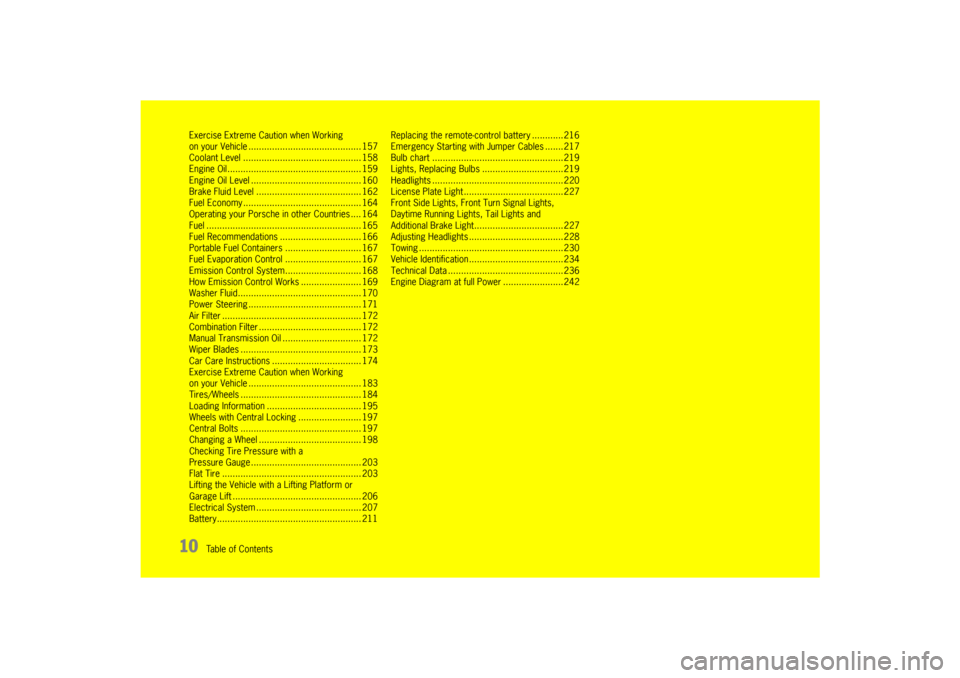
10
Table of Contents Exercise Extreme Caution when Working
on your Vehicle ........................................... 157
Coolant Level ............................................. 158
Engine Oil................................................... 159
Engine Oil Level .......................................... 160
Brake Fluid Level ........................................ 162
Fuel Economy ............................................. 164
Operating your Porsche in other Countries .... 164
Fuel ........................................................... 165
Fuel Recommendations............................... 166
Portable Fuel Containers ............................. 167
Fuel Evaporation Control ............................. 167
Emission Control System............................. 168
How Emission Control Works ....................... 169
Washer Fluid............................................... 170
Power Steering ........................................... 171
Air Filter ..................................................... 172
Combination Filter ....................................... 172
Manual Transmission Oil .............................. 172
Wiper Blades .............................................. 173
Car Care Instructions.................................. 174
Exercise Extreme Caution when Working
on your Vehicle ........................................... 183
Tires/Wheels .............................................. 184
Loading Information .................................... 195
Wheels with Central Locking ........................ 197
Central Bolts .............................................. 197
Changing a Wheel ....................................... 198
Checking Tire Pressure with a
Pressure Gauge .......................................... 203
Flat Tire ..................................................... 203
Lifting the Vehicle with a Lifting Platform or
Garage Lift ................................................. 206
Electrical System ........................................ 207
Battery....................................................... 211Replacing the remote-control battery ............216
Emergency Starting with Jumper Cables .......217
Bulb chart ..................................................219
Lights, Replacing Bulbs ...............................219
Headlights ..................................................220
License Plate Light ......................................227
Front Side Lights, Front Turn Signal Lights,
Daytime Running Lights, Tail Lights and
Additional Brake Light..................................227
Adjusting Headlights ....................................228
Towing .......................................................230
Vehicle Identification....................................234
Technical Data ............................................236
Engine Diagram at full Power .......................242
10_GT3_21.book Seite 10 Donnerstag, 4. Juni 2009 12:48 12
Page 12 of 251

Before driving off...
11
Dear Porsche Owner A lot has gone into the manufacture of your
Porsche, including advanced engineering, rigid
quality control and demanding inspections.
These engineering and safety features will be
enhanced by you... the safe driver... – who knows his/her car and all controls,
– who maintains the vehicle properly,
– who uses driving skills wisely and always
drives within her/his own capabilities and the
level of familiarity with the vehicle.
You will find helpful hints in this manual on how to
perform most of the checks listed on the following
pages.
If in doubt, have these checks performed by your
authorized Porsche dealer.
Before driving off... Check the following items first fTurn the engine off before you attempt any
checks or repairs on the vehicle.
fBe sure the tires are inflated correctly.
Check tires for damage and tire wear.
fSee that wheel bolts are properly tightened
and not loose or missing.
fCheck engine oil level, add if necessary.
Make it a habit to have engine oil checked with
every refueling.
fCheck all fluid levels such as windshield
washer and brake fluid levels.
fBe sure the vehicle battery is well charged and
cranks the engine properly.
fCheck all doors and lids for proper operation
and latch them properly.
fCheck, and if necessary replace worn or
cracked wiper blades.
fSee that all windows are clear and
unobstructed.
fCheck air intake slots and area between
luggage compartment lid and windshield.
Ensure that these areas are free of snow and
ice, so the heater and the windshield wipers
work properly. fIf a child will be riding in the vehicle, check
child seat/child seat restraint system to ensure
that restraints are properly adjusted.
fChild restraint systems will not fit into the
Sports bucket seat.
Do not install a child restraint system in the
Sports bucket seat.
The Sports bucket seat cannot be equipped
with the LATCH system and thus the airbag
system cannot be manually deactivated.
fCheck all exterior and interior lights for opera-
tion and that the lenses are clean.
fCheck the headlights for proper aim, and if
necessary, have them adjusted.
fCheck under the vehicle for leaks.
fBe sure all luggage is stowed securely.
Emergency equipment It is good practice to carry emergency equipment
in your vehicle.
Some of the items you should have are:
window scraper, snow brush, container or bag of
sand or salt, emergency light, small shovel, first-
aid kit, etc.
10_GT3_21.book Seite 11 Donnerstag, 4. Juni 2009 12:48 12
Page 13 of 251

12
Before driving off...
In the driver’s seat... fCheck operation of the horn.
fPosition seat for easy reach of foot pedals and
controls.
To reduce the possibility of injury from the
airbag deployment, you should always sit back
as far from the steering wheel as is practical,
while still maintaining full vehicle control.
fAdjust the inside and outside rear view mirrors.
fBuckle your safety belts.
fCheck operation of the foot and parking brake.
fCheck all warning and indicator lights with
ignition on and engine not running.
fStart engine and check all warning displays for
warning symbols.
fNever leave an idling car unattended.
fLock doors from inside, especially with
children in the car to prevent inadvertent
opening of doors from inside or outside.
Drive with doors locked.
On the road... fNever drive after you have consumed alcohol
or drugs.
fAlways have your safety belt fastened.
fAlways drive defensively.
Expect the unexpected.
fUse signals to indicate turns and lane changes.
fTurn on headlights at dusk or when the driving
conditions warrant it.
fAlways keep a safe distance from the vehicle in
front of you, depending on traffic, road and
weather conditions.
fReduce speed at night and during inclement
weather.
Driving in wet weather requires caution and
reduced speeds, particularly on roads with
standing water, as the handling characteristics
of the vehicle may be impaired due to hydropla-
ning of the tires.
fAlways observe speed limits and obey road
signs and traffic laws.
fWhen tired, get well off the road, stop and take
a rest. Turn the engine off. Do not sit in the
vehicle with engine idling.
Please see the chapter “ENGINE EXHAUST” on
Page 8.fWhen parked, always set the parking brake.
Move the gearshift lever to reverse or first
gear.
On hills also turn the front wheels toward the
curb.
fWhen emergency repairs become necessary,
move the vehicle well off the road. Turn on the
emergency flasher and use other warning
devices to alert other motorists. Do not park
or operate the vehicle in areas where the hot
exhaust system may come in contact with dry
grass, brush, fuel spill or other flammable
material.
fMake it a habit to have the engine oil checked
after every refueling.
10_GT3_21.book Seite 12 Donnerstag, 4. Juni 2009 12:48 12
Page 32 of 251
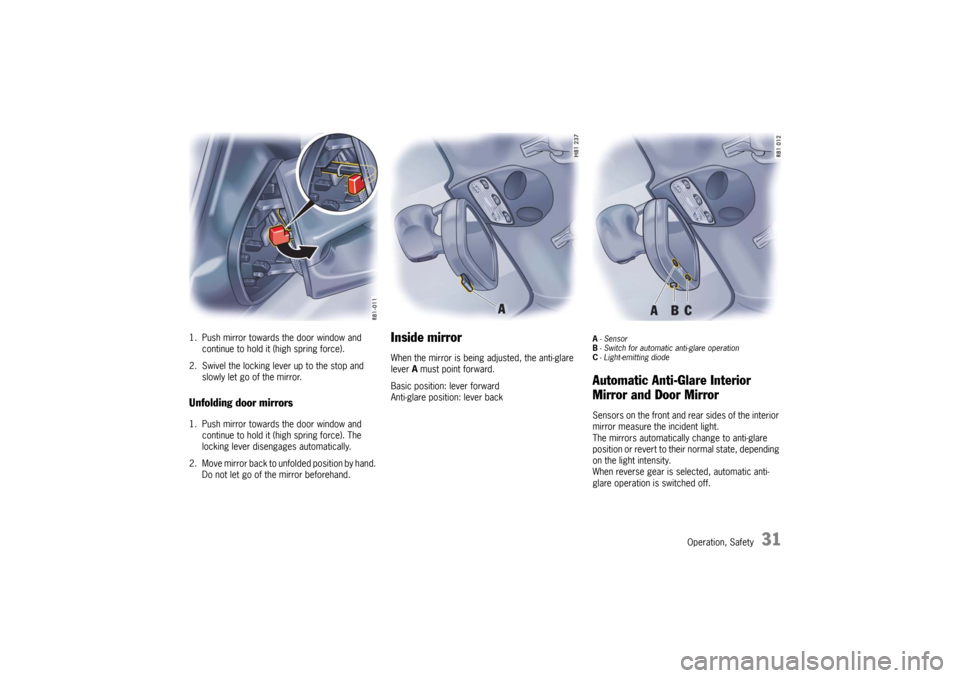
Operation, Safety
31
1. Push mirror towards the door window and
continue to hold it (high spring force).
2. Swivel the locking lever up to the stop and
slowly let go of the mirror.Unfolding door mirrors1. Push mirror towards the door window and
continue to hold it (high spring force). The
locking lever disengages automatically.
2. Move mirror back to unfolded position by hand.
Do not let go of the mirror beforehand.
Inside mirrorWhen the mirror is being adjusted, the anti-glare
lever A must point forward.
Basic position: lever forward
Anti-glare position: lever back
A-Sensor
B- Switch for automatic anti-glare operation
C- Light-emitting diode Automatic Anti-Glare Interior
Mirror and Door Mirror Sensors on the front and rear sides of the interior
mirror measure the incident light.
The mirrors automatically change to anti-glare
position or revert to their normal state, depending
on the light intensity.
When reverse gear is selected, automatic anti-
glare operation is switched off.
10_GT3_21.book Seite 31 Donnerstag, 4. Juni 2009 12:48 12
Page 40 of 251
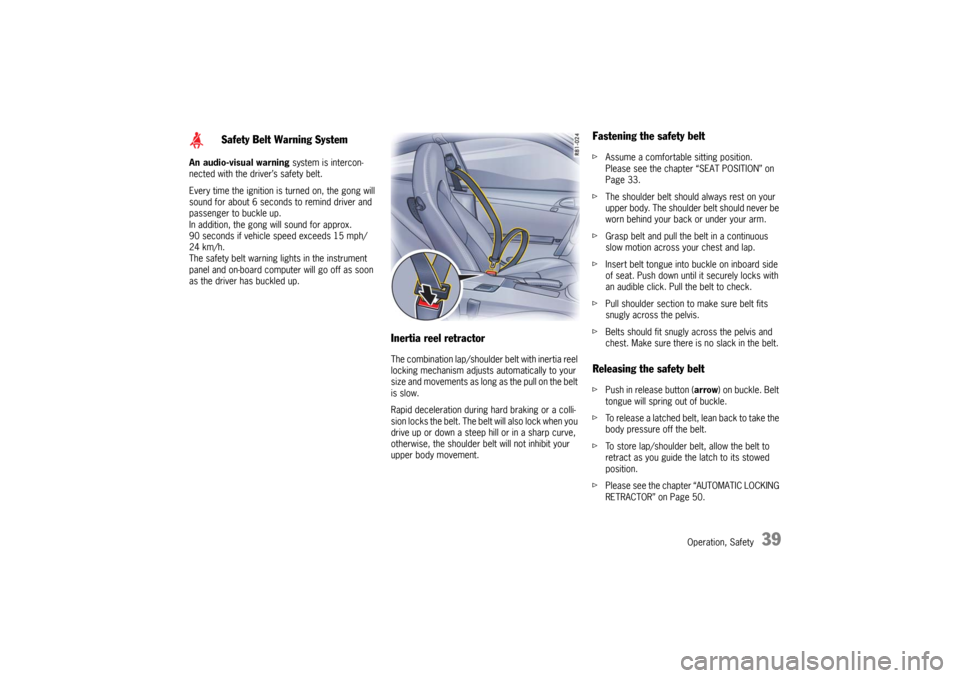
Operation, Safety
39
An audio-visual warning system is intercon-
nected with the driver’s safety belt.
Every time the ignition is turned on, the gong will
sound for about 6 seconds to remind driver and
passenger to buckle up.
In addition, the gong will sound for approx.
90 seconds if vehicle speed exceeds 15 mph/
24 km/h.
The safety belt warning lights in the instrument
panel and on-board computer will go off as soon
as the driver has buckled up.
Inertia reel retractor The combination lap/shoulder belt with inertia reel
locking mechanism adjusts automatically to your
size and movements as long as the pull on the belt
is slow.
Rapid deceleration during hard braking or a colli-
sion locks the belt. The belt will also lock when you
drive up or down a steep hill or in a sharp curve,
otherwise, the shoulder belt will not inhibit your
upper body movement.
Fastening the safety beltfAssume a comfortable sitting position.
Please see the chapter “SEAT POSITION” on
Page 33.
fThe shoulder belt should always rest on your
upper body. The shoulder belt should never be
worn behind your back or under your arm.
fGrasp belt and pull the belt in a continuous
slow motion across your chest and lap.
fInsert belt tongue into buckle on inboard side
of seat. Push down until it securely locks with
an audible click. Pull the belt to check.
fPull shoulder section to make sure belt fits
snugly across the pelvis.
fBelts should fit snugly across the pelvis and
chest. Make sure there is no slack in the belt. Releasing the safety beltfPush in release button (arrow) on buckle. Belt
tongue will spring out of buckle.
fTo release a latched belt, lean back to take the
body pressure off the belt.
fTo store lap/shoulder belt, allow the belt to
retract as you guide the latch to its stowed
position.
fPlease see the chapter “AUTOMATIC LOCKING
RETRACTOR” on Page 50.
Safety Belt Warning System
10_GT3_21.book Seite 39 Donnerstag, 4. Juni 2009 12:48 12
Page 55 of 251

54
Operation, Safety The warning lights in the instrument panel and on-
board computer will go out after the parking brake
is fully released.
The warning lights are not an indicator that the
parking brake is fully set; it is only intended to be
a warning to release the parking brake before
driving the car. Caution!
A partially engaged brake will overheat the
rear brakes, reduce their effectiveness and
cause excessive wear.
fRelease the parking brake fully.
fWhen parking your car, always set the parking
brake by pulling all the way up on the lever.
fMove the gearshift lever to reverse or first
gear.
fOn hills also turn the front wheels towards the
curb.
Brakes fMake it a habit to check the operation of your
brakes before driving.
Keep in mind that the braking distance increases
very rapidly as the speed increases. At 60 mph or
100 km/h, for example, it is not twice but four
times longer than 30 mph or 50 km/h. Tire
traction is also less effective when the roads are
wet or slippery.
fTherefore, always maintain a safe distance
from the car in front of you.
Vehicles without Porsche Ceramic Compo-
site Brake (PCCB)
Even though the brake discs consist of alloyed
grey cast iron, they will unavoidably start to
corrode if your car is parked for an extended
period. The brakes will tend to “rub” as a result.
The nature, extent and effects of corrosion
depend on the amount of time the vehicle was
parked, whether granular or liquid road salt was
spread and whether grease-dissolving agents
were used in car washes.
If the braking comfort is noticeably impaired, we
recommend having the brake system checked by
experts at an authorized Porsche dealer.
Brake system function Your Porsche is equipped with a power assisted
hydraulic dual circuit brake system with disc
brakes at the front and rear.
Both circuits function independently. One brake
circuit operates the front and the other operates
the rear.
If one brake circuit has failed, the other will still
operate. However, you will notice an increased
pedal travel when you apply the brakes.
Failure of one brake circuit will cause the stopping
distance to increase.
Warning!
Risk of an accident, resulting in serious
personal injury or death.
In the unlikely event of hydraulic failure of
one brake circuit:
fPush the brake pedal down firmly and hold it in
that position.
A mechanical linkage activates the second
circuit, and you will be able to bring the vehicle
to a stop.
fAfter bringing your vehicle to a complete stop,
avoid driving the vehicle and instead have it
towed to the nearest authorized Porsche dealer for repair.
Parking brake warning light USA
Parking brake warning light
Canada
10_GT3_21.book Seite 54 Donnerstag, 4. Juni 2009 12:48 12
Page 62 of 251
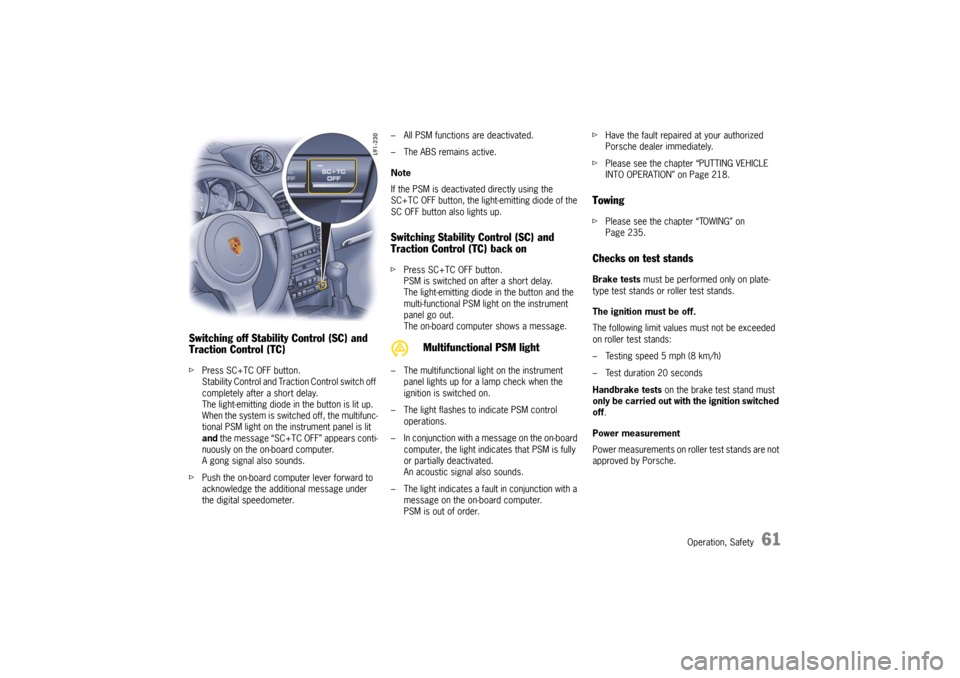
Operation, Safety
61
Switching off Stability Control (SC) and
Traction Control (TC)fPress SC+TC OFF button.
Stability Control and Traction Control switch off
completely after a short delay.
The light-emitting diode in the button is lit up.
When the system is switched off, the multifunc-
tional PSM light on the instrument panel is lit
and the message “SC+TC OFF” appears conti-
nuously on the on-board computer.
A gong signal also sounds.
fPush the on-board computer lever forward to
acknowledge the additional message under
the digital speedometer.– All PSM functions are deactivated.
– The ABS remains active.
Note
If the PSM is deactivated directly using the
SC+TC OFF button, the light-emitting diode of the
SC OFF button also lights up.
Switching Stability Control (SC) and
Traction Control (TC) back onfPress SC+TC OFF button.
PSM is switched on after a short delay.
The light-emitting diode in the button and the
multi-functional PSM light on the instrument
panel go out.
The on-board computer shows a message.
– The multifunctional light on the instrument
panel lights up for a lamp check when the
ignition is switched on.
– The light flashes to indicate PSM control
operations.
– In conjunction with a message on the on-board
computer, the light indicates that PSM is fully
or partially deactivated.
An acoustic signal also sounds.
– The light indicates a fault in conjunction with a
message on the on-board computer.
PSM is out of order.fHave the fault repaired at your authorized
Porsche dealer immediately.
fPlease see the chapter “PUTTING VEHICLE
INTO OPERATION” on Page 218.
TowingfPlease see the chapter “TOWING” on
Page 235.Checks on test standsBrake tests must be performed only on plate-
type test stands or roller test stands.
The ignition must be off.
The following limit values must not be exceeded
on roller test stands:
– Testing speed 5 mph (8 km/h)
– Test duration 20 seconds
Handbrake tests on the brake test stand must
only be carried out with the ignition switched
off.
Power measurement
Power measurements on roller test stands are not
approved by Porsche.
Multifunctional PSM light
10_GT3_21.book Seite 61 Donnerstag, 4. Juni 2009 12:48 12
Page 76 of 251
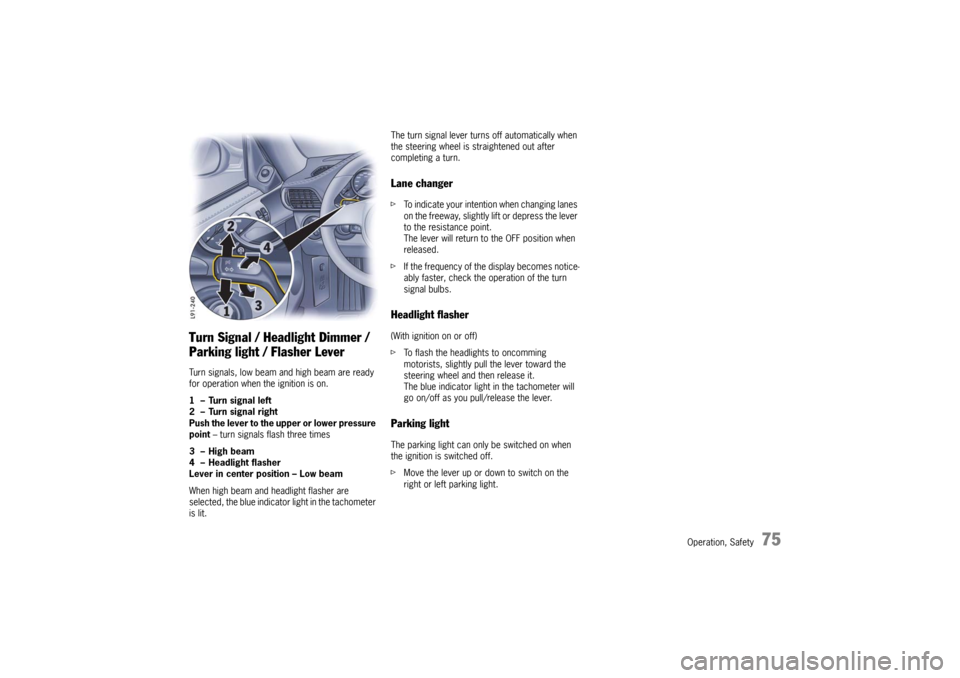
Operation, Safety
75
Turn Signal / Headlight Dimmer /
Parking light / Flasher Lever Turn signals, low beam and high beam are ready
for operation when the ignition is on.
1 – Turn signal left
2 – Turn signal right
Push the lever to the upper or lower pressure
point – turn signals flash three times
3 – High beam
4 – Headlight flasher
Lever in center position – Low beam
When high beam and headlight flasher are
selected, the blue indicator light in the tachometer
is lit. The turn signal lever turns off automatically when
the steering wheel is straightened out after
completing a turn.
Lane changer fTo indicate your intention when changing lanes
on the freeway, slightly lift or depress the lever
to the resistance point.
The lever will return to the OFF position when
released.
fIf the frequency of the display becomes notice-
ably faster, check the operation of the turn
signal bulbs. Headlight flasher (With ignition on or off)
fTo flash the headlights to oncomming
motorists, slightly pull the lever toward the
steering wheel and then release it.
The blue indicator light in the tachometer will
go on/off as you pull/release the lever. Parking lightThe parking light can only be switched on when
the ignition is switched off.
fMove the lever up or down to switch on the
right or left parking light.
10_GT3_21.book Seite 75 Donnerstag, 4. Juni 2009 12:48 12
Page 77 of 251
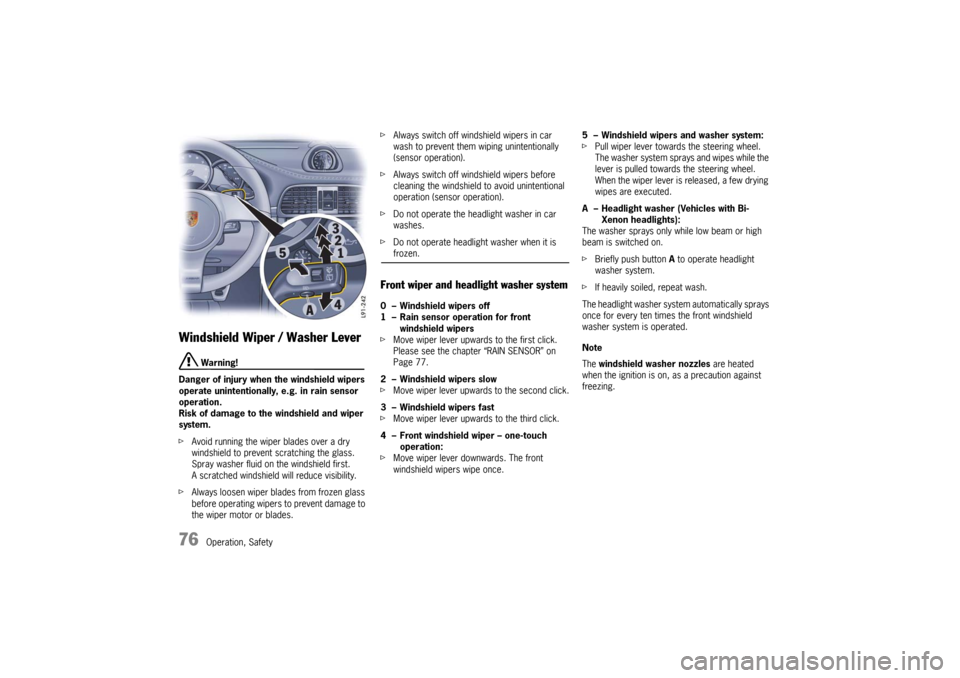
76
Operation, Safety
Windshield Wiper / Washer Lever
Warning!
Danger of injury when the windshield wipers
operate unintentionally, e.g. in rain sensor
operation.
Risk of damage to the windshield and wiper
system.
fAvoid running the wiper blades over a dry
windshield to prevent scratching the glass.
Spray washer fluid on the windshield first.
A scratched windshield will reduce visibility.
fAlways loosen wiper blades from frozen glass
before operating wipers to prevent damage to
the wiper motor or blades. fAlways switch off windshield wipers in car
wash to prevent them wiping unintentionally
(sensor operation).
fAlways switch off windshield wipers before
cleaning the windshield to avoid unintentional
operation (sensor operation).
fDo not operate the headlight washer in car
washes.
fDo not operate headlight washer when it is
frozen.
Front wiper and headlight washer system0 – Windshield wipers off
1 – Rain sensor operation for front
windshield wipers
fMove wiper lever upwards to the first click.
Please see the chapter “RAIN SENSOR” on
Page 77.
2 – Windshield wipers slow
fMove wiper lever upwards to the second click.
3 – Windshield wipers fast
fMove wiper lever upwards to the third click.
4 – Front windshield wiper – one-touch
operation:
fMove wiper lever downwards. The front
windshield wipers wipe once.5 – Windshield wipers and washer system:
fPull wiper lever towards the steering wheel.
The washer system sprays and wipes while the
lever is pulled towards the steering wheel.
When the wiper lever is released, a few drying
wipes are executed.
A – Headlight washer (Vehicles with Bi-
Xenon headlights):
The washer sprays only while low beam or high
beam is switched on.
fBriefly push button A to operate headlight
washer system.
fIf heavily soiled, repeat wash.
The headlight washer system automatically sprays
once for every ten times the front windshield
washer system is operated.
Note
The windshield washer nozzles are heated
when the ignition is on, as a precaution against
freezing.
10_GT3_21.book Seite 76 Donnerstag, 4. Juni 2009 12:48 12